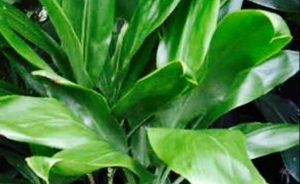Ti Leaf: Canoe Plant of Ancient Hawai‘i
Cordyline fruitcosa, one of the canoe plants introduced to Hawai‘i by the early Polynesians, served many purposes, providing food, medicine, shelter, clothing and footwear—as well as great spiritual power—for early Hawaiians.
The original plant was a tall stalk with tightly clustered, green, oval, blade-shaped leaves.
The leaf was about four inches wide and varied in length from one to two feet.
The Hawaiians call it “ki;” it is commonly known today as ti leaf.
The early Polynesians made a shingled type ti leaf cape called the “kui la‘i” that helped shelter them from the rain and the cold.
Dried ti leaves were also woven into sandals.
Leaves were also used to make thatched roofs for their homes.
The ti leaves ability to shed water comes from the protective surface called the “cuticle.” The leaf is covered with a waxy cuticle that keeps water outside and prevents water from evaporating from the plant.
Sacred to the Hawaiian demigod Lono and also to the goddess of hula, Laka, the leaves were used by kahuna (high priests) in their ancient ceremonial rituals to ward off evil spirits and to call upon the good spirits.
Early Hawaiians believed that the ti leaf plant had great spiritual power, which meant that only the kahuna and the ali‘i (chiefs) were allowed to wear the leaves around their necks during certain ceremonies and ritual activities.
There are many medicinal benefits provided by the entire ti leaf plant. The fragrant flowers are used to help asthma, while the steam from boiled young shoots and leaves makes a very effective decongestant.
To help with injuries, warm stones were wrapped with ti leaf to serve as hot packs.
Many people local people have benefitted from a ti leaf poultices applied to their fevered brows, as it helped to break the fever.
The boiled roots were brewed into a potent liquor known as ‘okolehao—not to be confused with the tonic made from boiling the green leaves that helps to aid nerve and muscle relaxation.
The large, sweet, starchy roots were baked and eaten as a dessert.
The uses of ti leaf have grown since the initial plants were brought here on canoe many hundreds of years ago. Today it is one of the most commonly used green leaves used in the food service industry. While not edible, it is often used as an alternative to aluminum foil.
One need not look very far to find a ti leaf plant here in Hawai‘i, and in fact, it is said to be good luck to have a few planted on your property… to ward off the evil spirits.
















